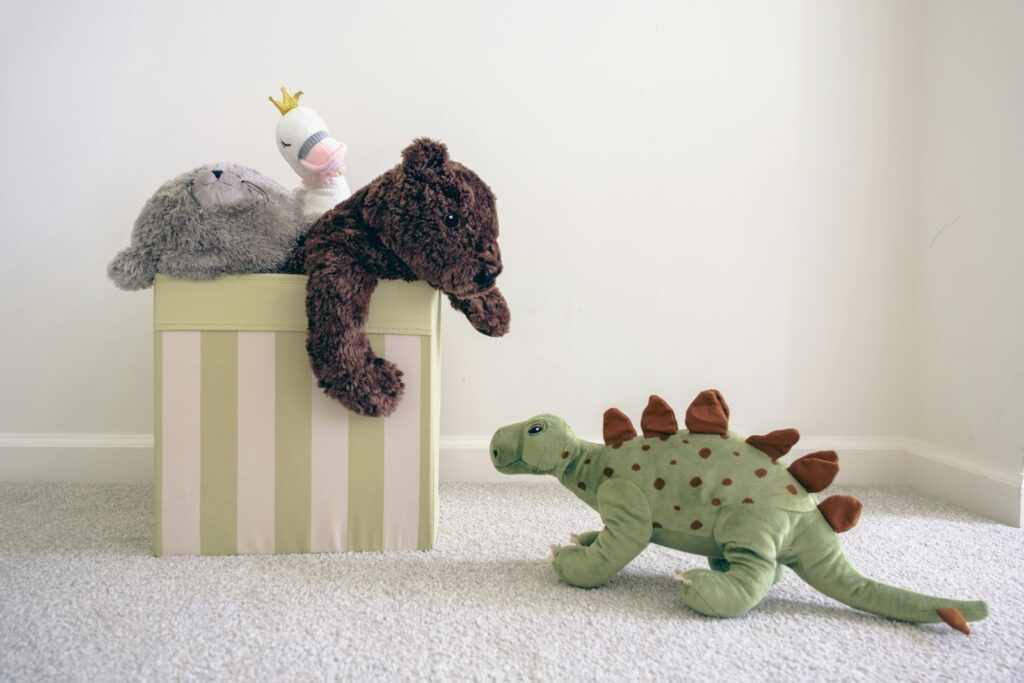Dinosaur toys have captured the imagination of children and collectors for generations, evolving dramatically from simple clay figurines to sophisticated interactive models with cutting-edge technology. This fascinating journey reflects not only advances in manufacturing and technology but also our growing scientific understanding of these prehistoric creatures.
As paleontological discoveries reshape our knowledge of dinosaurs, toy manufacturers have continuously adapted their designs, creating an entire industry that balances scientific accuracy with playful engagement. From the crude, anatomically incorrect models of the early 20th century to today’s museum-quality replicas and augmented reality experiences, dinosaur toys tell a story of innovation, education, and enduring fascination with the ancient beasts that once ruled our planet.
The Prehistoric Beginnings of Dinosaur Toys
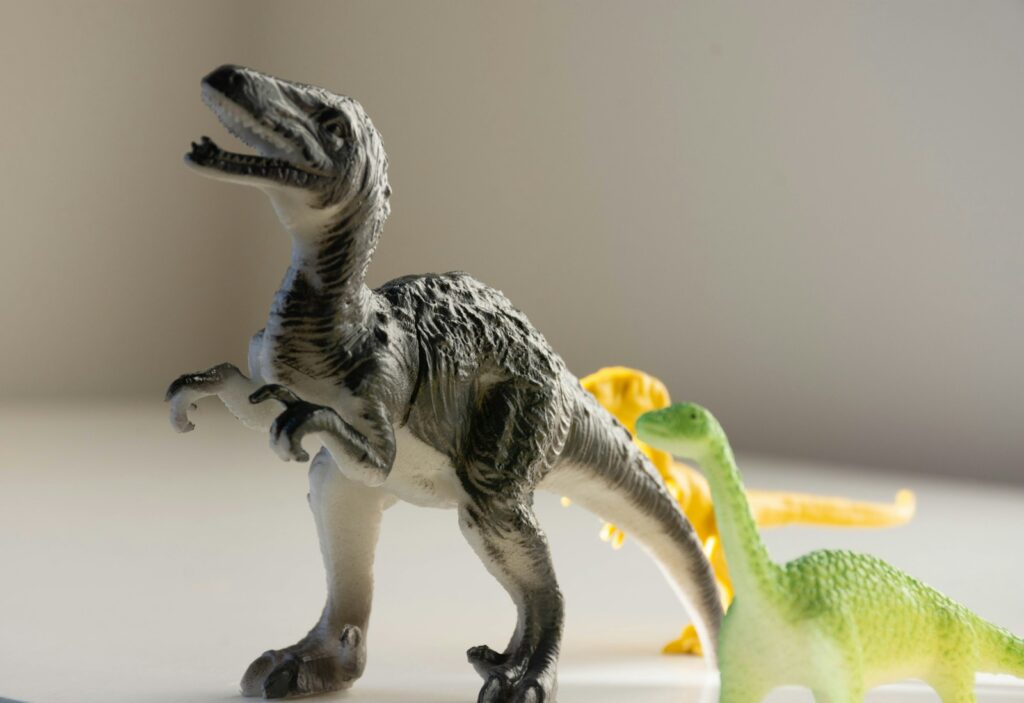
The earliest dinosaur toys emerged in the late 19th and early 20th centuries, shortly after dinosaurs captured the public imagination following major fossil discoveries. These pioneering models were typically handcrafted from materials like clay, wood, or metal, reflecting the limited manufacturing capabilities of the era. Companies like Lineol and O. Höller in Germany produced some of the first commercial dinosaur figurines around the 1910s and 1920s.
These early representations were notably inaccurate by modern standards, often depicting dinosaurs as lumbering, lizard-like creatures dragging their tails—a reflection of the scientific understanding at that time. Despite their inaccuracies, these primitive toys laid the foundation for what would become a thriving category in the toy industry and sparked an enduring fascination with prehistoric life among generations of children.
The Mid-Century Plastic Revolution
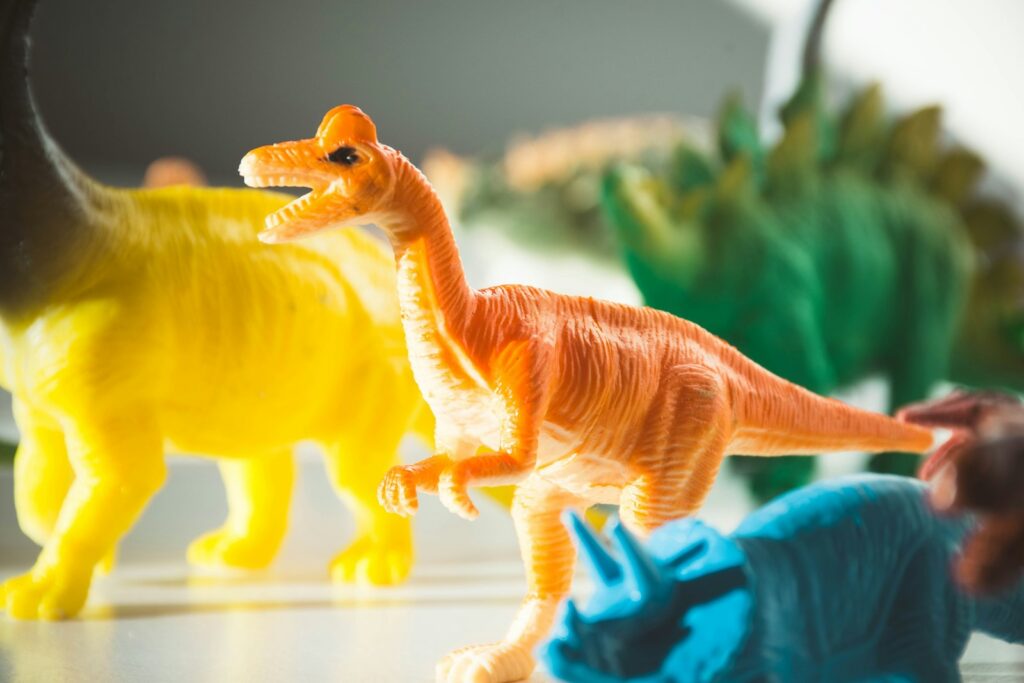
The post-World War II era brought revolutionary changes to dinosaur toys with the advent of plastic manufacturing. This new material allowed for mass production of affordable, durable dinosaur figures that could reach a much wider audience than their predecessors. Companies like Marx Toys and Multiple Products (later known as MPC) began producing plastic dinosaur sets that became staples in American households during the 1950s and 1960s. The iconic green army men-style dinosaurs—small, monochromatic figures sold in bags or buckets—became particularly widespread during this period.
While these toys still perpetuated many scientific inaccuracies, such as upright T. rexes and bipedal Brontosaurus models, they nevertheless helped cement dinosaurs as cultural icons in children’s play. The democratization of dinosaur toys through plastic manufacturing also coincided with broader public education about prehistoric life, creating a feedback loop of growing interest and product development.
The Dinosaur Renaissance in Toy Design
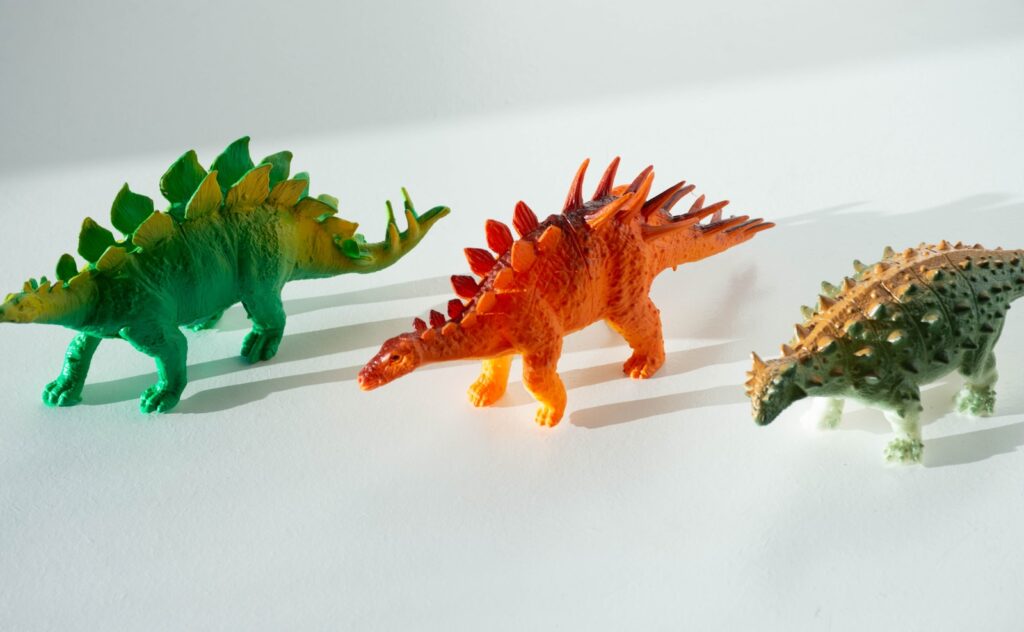
The 1970s and 1980s witnessed what paleontologists call the “Dinosaur Renaissance”—a period of dramatic revision in scientific understanding that portrayed dinosaurs as more active, intelligent, and bird-like than previously thought. This scientific revolution eventually transformed dinosaur toys, though not immediately. Companies like Invicta Plastics, working with the British Museum of Natural History, began producing more scientifically accurate dinosaur figurines in the late 1970s.
The “Invicta Dinosaurs” collection represented one of the first attempts to incorporate current scientific knowledge into mass-produced toys. During this period, we also saw the introduction of more detailed dinosaur models with features like textured skin and articulated limbs. This era marked a significant shift toward educational value in dinosaur toys, with manufacturers beginning to emphasize scientific accuracy as a selling point—a trend that would accelerate in subsequent decades as paleontological discoveries continued to reshape our understanding of how dinosaurs looked and behaved.
Jurassic Park and the Multimedia Dinosaur Explosion

The 1993 release of Steven Spielberg’s “Jurassic Park” revolutionized dinosaur toys and created an unprecedented surge in their popularity. The film’s groundbreaking visual effects brought dinosaurs to life with unprecedented realism, and Kenner’s accompanying toy line became one of the most successful movie merchandise programs of all time. These toys featured electronic sounds, realistic skin textures, and “Dino-Damage” wound features that revealed simulated flesh and bone beneath removable skin patches.
The Jurassic Park phenomenon transcended traditional action figures to include vehicles, playsets, and various electronic toys that capitalized on the film’s popularity. This multimedia approach created a more immersive play experience, allowing children to recreate scenes from the movie or invent their own dinosaur adventures. The film and its merchandise also helped popularize previously lesser-known dinosaurs like Velociraptor, which became household names virtually overnight. This marketing juggernaut demonstrated how scientific concepts could be successfully commercialized through entertainment, forever changing the landscape of dinosaur toys.
The Rise of Scientifically Accurate Collectibles

By the late 1990s and early 2000s, a new market segment emerged focused on highly detailed, scientifically accurate dinosaur figures targeted primarily at adult collectors. Companies like Safari Ltd., Papo, and Schleich began producing museum-quality replicas that incorporated the latest paleontological findings. These premium collectibles featured detailed skin textures, anatomically correct proportions, and postures that reflected current scientific understanding.
The rise of the internet and social media allowed collectors to connect with manufacturers and paleontologists, creating feedback loops that improved accuracy even further. Some companies began collaborating directly with paleontologists as consultants to ensure their products reflected the most up-to-date scientific knowledge. This period also saw the introduction of feathered dinosaur models following groundbreaking fossil discoveries that confirmed the evolutionary link between dinosaurs and birds.
These high-end collectibles, while often too fragile or expensive for younger children’s play, helped establish new standards for accuracy that would eventually influence mainstream toy lines as well.
Educational Dinosaur Kits and Models

The educational potential of dinosaurs became increasingly central to toy design in the 2000s, with the proliferation of dinosaur skeleton kits, fossil excavation sets, and anatomical models. Companies like 4M and National Geographic created popular kits that allowed children to assemble dinosaur skeletons from plastic or wooden pieces, simulating the work of paleontologists. Excavation kits, featuring plaster blocks containing simulated fossils that children could carefully chisel away to discover, became particularly popular for their hands-on learning approach.
These educational toys merged play with scientific concepts and helped cultivate skills like patience, fine motor control, and deductive reasoning. The accompanying educational materials often included information about geology, evolution, and extinction events, expanding children’s understanding beyond just dinosaur identification. This educational focus reflected a growing parental desire for toys that combined entertainment value with learning opportunities, positioning dinosaur toys as tools for fostering scientific curiosity and critical thinking skills in young minds.
Animatronic Dinosaurs and Interactive Technology

Advancements in electronics during the 2000s and 2010s led to increasingly sophisticated animatronic dinosaur toys that could move, roar, and respond to human interaction. Products like Hasbro’s “Real Feel” dinosaurs and WowWee’s Roboraptor incorporated sensors, programmable movements, and realistic sound effects that created more immersive play experiences. These high-tech toys often featured remote controls or responded to touch, sound, or motion, allowing children to interact with their dinosaur companions in novel ways.
Some models included artificial intelligence components that simulated different moods or behaviors, creating the illusion of a living pet rather than just a toy. As technology became more sophisticated, these interactive features became more complex, with some high-end models capable of recognizing voice commands or learning patterns of interaction over time. While significantly more expensive than traditional figurines, these animatronic dinosaurs represented a new frontier in imaginative play, blurring the boundaries between toys, robotics, and digital pets.
Building Block Dinosaurs: LEGO and Beyond
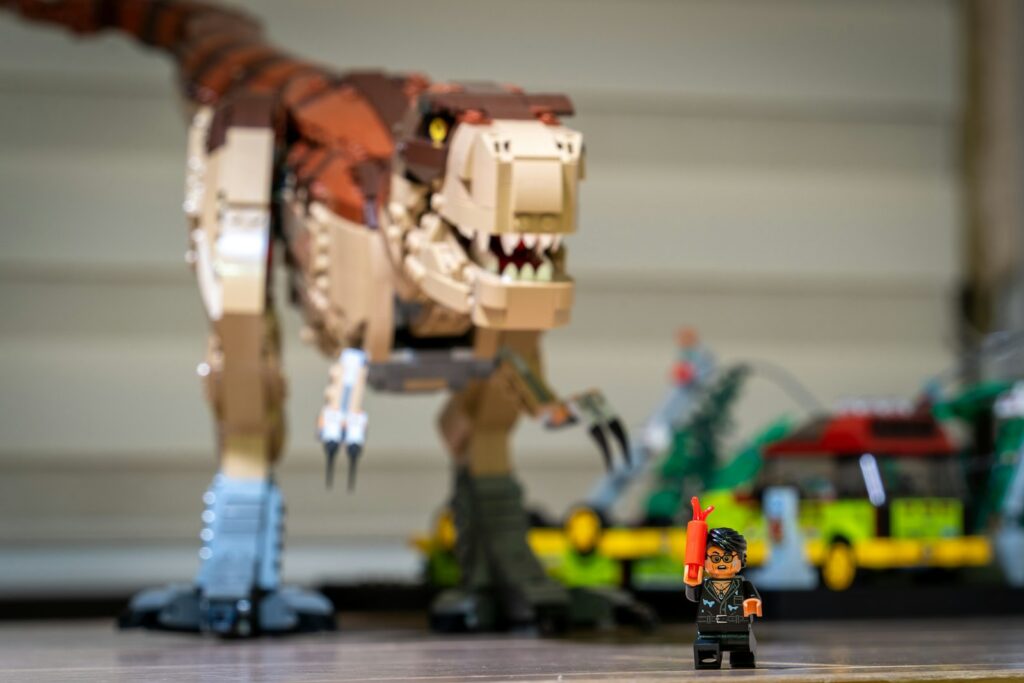
Construction toys have long embraced dinosaur themes, with LEGO leading the charge through various dinosaur-themed sets released since the 1990s. The LEGO Dino Island sets of the late 1990s, followed by Dino Attack and Dino series in the 2000s and 2010s, allowed children to build both dinosaurs and accompanying vehicles or environments.
These construction sets encouraged creativity while developing spatial reasoning and following instructions—valuable cognitive skills beyond just dinosaur knowledge. LEGO’s Jurassic World licensed sets, coinciding with the revitalized film franchise starting in 2015, have been particularly successful in combining recognizable movie elements with the building block format.
Beyond LEGO, companies like K’NEX, Mega Construx, and Playmobil have created their own dinosaur construction sets with varying complexity levels suitable for different age groups. The appeal of building block dinosaurs lies in their interactivity—children actively participate in creating their dinosaur models rather than simply receiving a completed figure, fostering a deeper connection to both the toy and the prehistoric creatures they represent.
Dinosaur Toys in the Digital Age

The digital revolution has transformed how children interact with dinosaur toys through augmented reality (AR) and virtual reality (VR) technologies that blend physical toys with digital experiences. Products like Mattel’s Jurassic World Facts app allow children to scan their dinosaur figures to unlock digital content, animations, and educational information about each species.
Some AR-enabled dinosaur toys project virtual dinosaurs into the real world through smartphone or tablet cameras, creating immersive experiences where digital dinosaurs appear to interact with the physical environment. Companies like Tomy with their “Pictory” line have created dinosaur picture books that come to life through AR apps, while others have developed digital games that use physical dinosaur figures as controllers or game pieces.
These hybrid physical- digital experiences represent a significant evolution in how children engage with dinosaur play, offering unprecedented levels of interactivity and educational content. The integration of digital elements also allows toy manufacturers to update information as new scientific discoveries emerge, keeping the educational content current without requiring new physical products.
Dinosaur Plush Toys and Character Merchandising
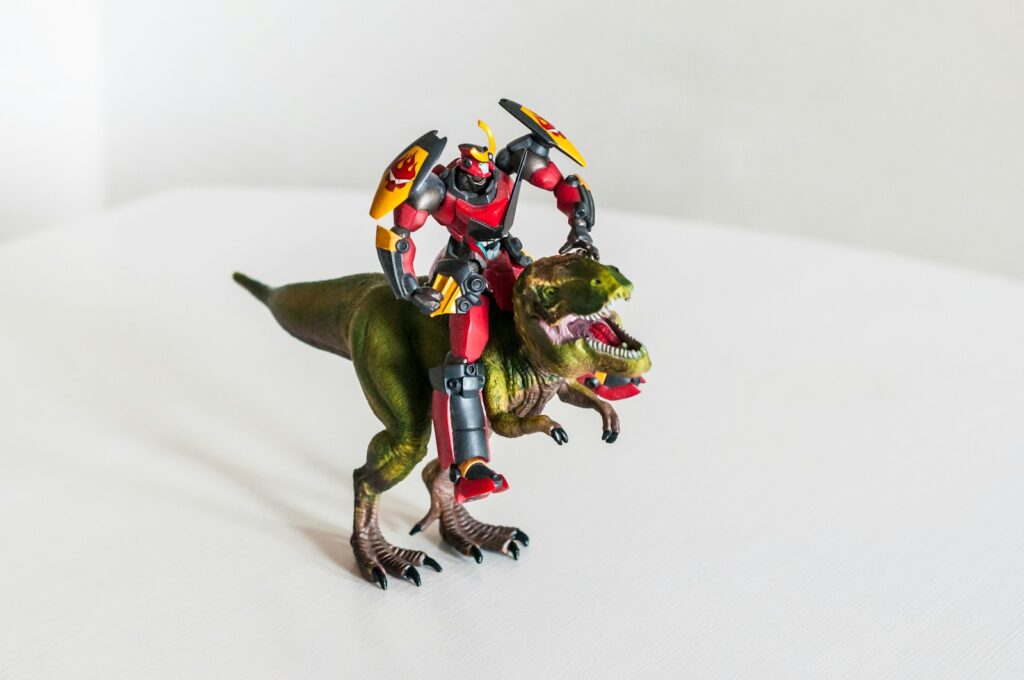
Soft dinosaur plush toys have emerged as a popular category that makes prehistoric creatures more approachable for younger children compared to their more realistic and sometimes frightening counterparts. Companies like Aurora World, Wild Republic, and GUND have created extensive lines of huggable dinosaur plushies that combine scientific accuracy with child-friendly designs.
Beyond traditional plush toys, character merchandising from properties like “The Land Before Time,” “Dinosaur Train,” and “Gigantosaurus” has created more emotionally engaging dinosaur toys based on animated personalities rather than strictly scientific representations. These character-based dinosaur toys often incorporate bright colors, exaggerated features, and anthropomorphic expressions that appeal to preschoolers and young children still developing their understanding of prehistoric life.
The emotional connection children form with these character-based dinosaur toys often serves as a gateway to more scientific interest as they mature, making them an important entry point into dinosaur fascination. The enduring popularity of dinosaur plush toys also demonstrates the psychological comfort that children find in transforming potentially scary prehistoric predators into cuddly companions.
The Customization and 3D Printing Revolution
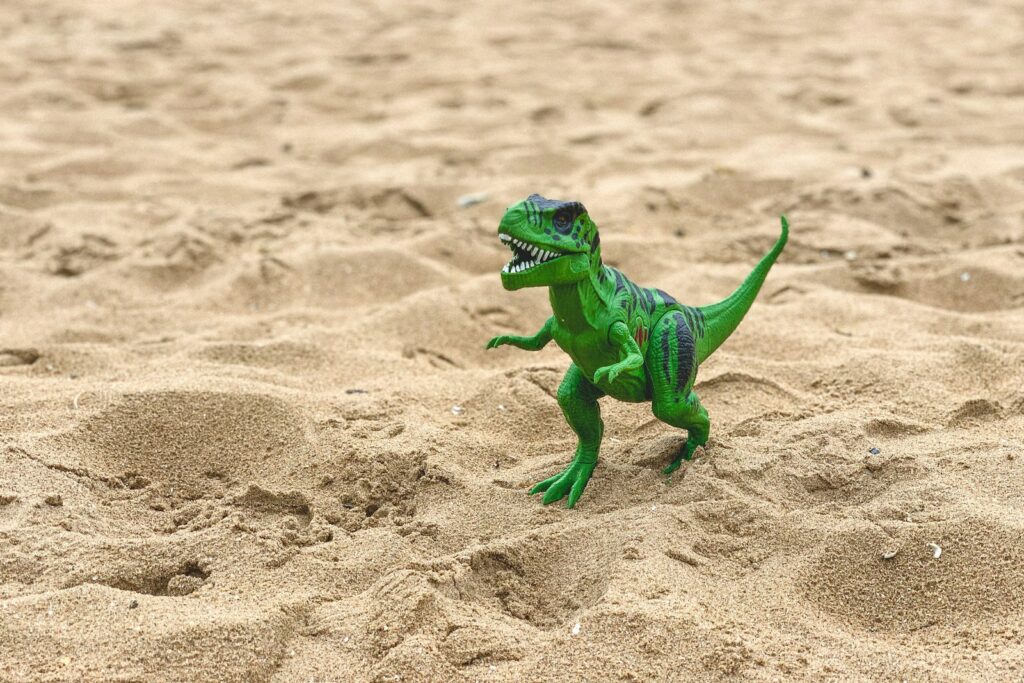
The advent of 3D printing technology has democratized dinosaur toy production, allowing for unprecedented customization and small-batch manufacturing of highly specialized models. Independent designers and small companies can now create and sell unique dinosaur figures that might be too niche for mass production, such as lesser-known species or specific variants based on the latest fossil discoveries.
Platforms like Shapeways and Etsy host numerous creators selling 3D-printed dinosaur models ranging from educational skeleton replicas to artistic interpretations. Some paleontologists and museums have embraced this technology to make digital scans of their fossil collections available for home printing, blurring the line between scientific resource and toy.
The customization extends beyond just printing, with some companies offering paint-your-own dinosaur kits or modular designs where children can mix and match parts to create hybrid creatures. This technological revolution has empowered consumers to participate more actively in the creation process and has fostered a vibrant community of dinosaur toy enthusiasts sharing designs, painting techniques, and scientific information online.
Ethical and Sustainable Dinosaur Toys

The growing focus on environmental sustainability has influenced the dinosaur toy market, with manufacturers increasingly considering the ecological impact of their products. Several companies now offer dinosaur toys made from sustainable materials like FSC-certified wood, recycled plastic, or biodegradable compounds as alternatives to traditional petroleum-based plastics.
Brands like PlanToys and BeginAgain create wooden dinosaur toys and puzzles that appeal to environmentally conscious parents concerned about chemical exposure and environmental impact. Some manufacturers have embraced bioplastics derived from renewable resources such as corn or sugarcane to create more eco-friendly dinosaur figures. Beyond materials, packaging has also evolved, with reduced plastic, recycled cardboard, and soy-based inks becoming more common in the dinosaur toy sector.
The irony of using unsustainable materials to create toys representing extinct species has not been lost on consumers or manufacturers, driving this push toward more environmentally responsible production methods. This trend reflects broader cultural shifts toward sustainability and indicates how even longstanding toy categories like dinosaur figures continue to evolve in response to changing social values and consumer preferences.
The Future of Dinosaur Toys: Emerging Trends and Technologies

The future of dinosaur toys promises even greater integration of advanced technologies and scientific accuracy. Emerging technologies like holographic displays, more sophisticated artificial intelligence, and haptic feedback systems will likely create increasingly immersive dinosaur play experiences. Some companies are already experimenting with voice-activated dinosaur companions that can engage in rudimentary conversations and answer questions about prehistoric life.
The growing field of paleogenetics—which studies ancient DNA—may influence future dinosaur toy designs as we gain better understanding of dinosaur coloration, soft tissue structures, and other features not preserved in typical fossils. We may also see more personalized experiences, with toys that adapt their educational content based on a child’s age, interests, and knowledge level.
The boundaries between educational tools and toys will likely continue to blur, with more dinosaur toys designed explicitly to align with science curriculum standards while maintaining play value. As virtual and augmented reality technologies mature, we’ll likely see dinosaur toys that serve as physical anchors to increasingly sophisticated digital worlds where children can interact with virtual prehistoric environments in ways previous generations could only imagine.
Conclusion: The Enduring Appeal of Dinosaur Toys

From simple clay figurines to AI-enhanced interactive models, dinosaur toys have undergone a remarkable evolution that mirrors advancements in manufacturing, technology, and scientific understanding. Despite these dramatic changes, the fundamental appeal of dinosaur toys remains constant—they connect children to a mysterious prehistoric world that sparks imagination and curiosity.
These toys serve multiple purposes: as scientific education tools, creative play objects, collectibles, and bridges between generations as parents share their own childhood dinosaur fascinations with their children. The staying power of dinosaur toys in an era of digital entertainment speaks to the profound psychological appeal of these ancient creatures who represent both the awesome power of nature and the enduring mysteries of our planet’s history.
As we look to the future, dinosaur toys will undoubtedly continue to evolve, incorporating new technologies and scientific discoveries while maintaining that essential sense of wonder that has captivated children for well over a century. In this ongoing evolution, dinosaur toys remain not just playthings but cultural artifacts that reflect our changing relationship with science, technology, and the natural world.

